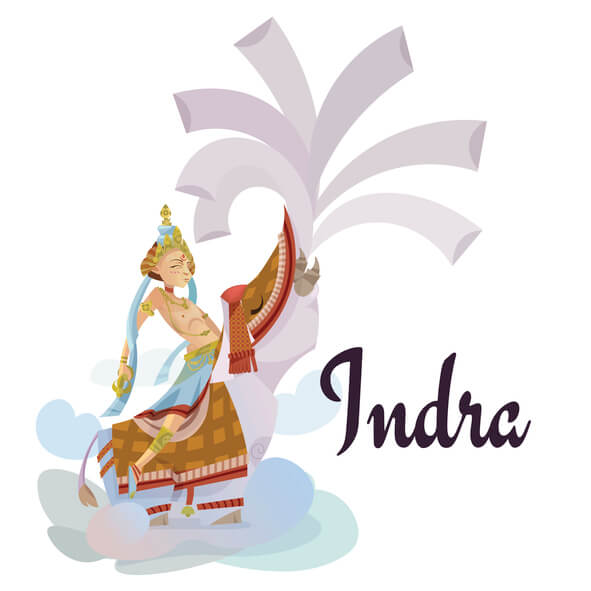Every religion has the concept of the so-called sky father, a king of gods, an all-powerful deity. Some of these stories are still popular and well-known today, like the stories of Thor and Zeus. Others are a bit less known in popular culture, like Jupiter, Perun, and the Hindu equivalent of those great gods: Indra.
Although he is a god that is not as well known now as he was when his story was first told, Indra is no less significant for our inner growth. The slayer of demons and the god of storms, Indra teaches us that we all have a storm within us; a mighty and powerful force which can both create and destroy.
Indra’s name means “the one who possess water,” referring to his rule of water, both of rivers, lakes and seas, and of the rains that come with storms and thunder.
The King of the Gods
In the early Vedic period, Indra was celebrated and worshipped as the king of all gods and a mighty warrior. He was known as the god of rain, thunder, and war, and as the slayer of anti-gods and demons.
Indra was depicted as the protector of cows, priests, and gods. The Rig Veda contains dozens of hymns dedicated to Indra. In fact, there are more hymns dedicated to Indra in the Hindu sacred texts than to any other god!
Indra’s most heroic feat was the defeat of Vritra. Vritra was a dragon-shaped demon, an asura who led the dasas. Vritra was accused of many horrendous acts that harmed humanity, such as hiding the Sun, keeping all the rains to himself (he was known as the embodiment of draught), and stealing cows.
Indra defeated him, releasing all the waters to Earth and feeding the soil, thus making it fertile and healthy. Effectively, he also freed the Sun, making life on Earth possible, and freed all the cows – sacred animals in Hinduism.
The God of Thunder
In the later Vedic period, Indra is no longer worshipped, and the texts see him reduced to a smaller role in mythology, but nevertheless still significant. In later Hinduism, Indra is no longer seen as the protector and ruler of all gods, and he is a lesser god than the trinity of Shiva, Brahma and Vishnu. However, he is still the king of heaven, the place where all the gods reside, and he still rules over lesser deities. Specifically, he is the king of all gods, except the sacred trinity.
The powers Indra does consistently maintain throughout Hindu mythology is the power over water. Indra is regarded as the ruler of all waters, be it the seas, oceans, rivers or lakes, or the rain that falls from the sky. He is known as the god of thunder and ruler of the sky.
Read: An Introduction to Lord Shiva: The Destroyer
Depictions in Art
In art, Indra is depicted as having four arms. In each hand he is carrying a weapon: a thunderbolt, a sword, a noose, and a hook.

He is represented riding an elephant with a rainbow coloring the sky behind him. The elephant is no random elephant, but fittingly the king of all elephants: Airavata.
The Defender of Mankind
Indra’s biggest achievement was the slaying of Vritra, the symbolic representation of all evil. A great warrior and a god of war, Indra is known for being the greatest slayer of demons, who themselves represent all that tempts and corrupts humans. This means that Indra is symbolically the defender of mankind.
Indra protects us not only from the evils that are outside of us, but from the evils that our within us as well. By defeating demons, Indra symbolically defends us from our inner demons; from all that is dark within us, from temptation, greed, and egotism.
Indra also protects us from poverty and hunger by blessing the soil with rain and by giving us all the waters that we rely on for so much in our lives.
Read: Hinduism's Most Popular Deities
The Power to Destroy
Indra’s powers have deep and intricate symbolic meaning, and challenge our preconceived notions of certain qualities, such as destruction. We are inclined to associate destructiveness with something negative, but Indra is the symbol of positive, fruitful destruction.
Indra is not referred to as the god of water, although this is what he is and what is even in his name. Instead, he is called the god of thunder. This is an important aspect of Indra to keep in mind.

Storms are both good and bad. Storms are positive because they bring us water – the rain that feeds the earth, enabling it to grow plants which humans and animals eat to survive. The rain feeds the rivers and the oceans as well, bringing us the water which we use to drink, bathe, and create the energy necessary for up-keeping a modern lifestyle.
On the other hand, storms are also violent, and the strong winds and lightning can destroy what we have built and even kill people and animals alike.
On a symbolic level, Indra represents the power to destroy used for good. He, in fact, is a ruthless killer, but he kills demons and anti-gods. Just like a storm, he has the potential for both good and evil, but he chooses to use his powers for good, and he destroys only that which causes harm.
Read: Light and Dark: The Spectrum of Human Experience
Indra and Yoga
A devoted yogi will focus on Indra’s lethal lightning bolt and how he uses it to slay demons and try to emulate this power. Indra’s myth teaches us that we ourselves are just like a storm; we have the potential to create and to destroy, and it is up to us to choose to use this power for good and for creation.
However, Indra doesn’t withhold this power to destroy and neither should we. Indra teaches us to use the lightning bolt, which we each have within us, not only to fight for what is good and righteous, but to fight our own inner demons.

When meditating on Indra, one reflects on their own ability to slay demons. All of us have certain negative influences and negative traits within ourselves, our own personal demons: greed, jealousy, addiction, dishonesty.
Like Indra, we should connect with the storm within us and use our potential for destruction to destroy these demons and liberate ourselves from the negative traits which entrap and endanger us.
Indra represents our own power to set ourselves free and reminds us that we ourselves carry the power to change our lives and better ourselves.
During These Times of Stress and Uncertainty Your Doshas May Be Unbalanced.
To help you bring attention to your doshas and to identify what your predominant dosha is, we created the following quiz.
Try not to stress over every question, but simply answer based off your intuition. After all, you know yourself better than anyone else.